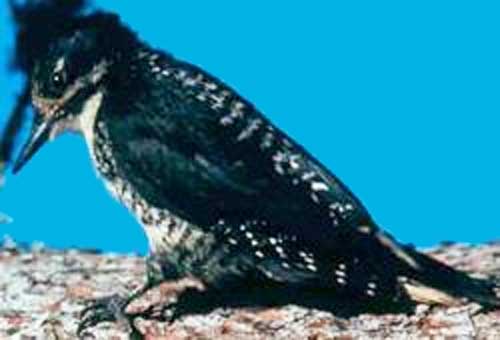Picoides tridactylus (USDA Forest Service) Cladus: Eukaryota Name Picoides tridactylus (Linnaeus, 1758) References * Systema Naturae ed.10 p.114
The Three-toed Woodpecker, Picoides tridactylus, is a medium-sized woodpecker. The adult is 21.5-24 cm in length. It is black on the head, wings and rump, and white from the throat to the belly; the flanks are white with black bars. The back is white with black bars, and the tail is black with the white outer feathers barred with black. The adult male has a yellow cap. In North America, the Three-toed Woodpecker can be confused with the Black-backed Woodpecker, which it closely resembles. Identification is easier in Eurasia, where it is the only woodpecker with a yellow cap, the only one with three toes, and one of only two black-and-white woodpeckers that lack any red in the plumage. The Three-toed Woodpecker can be distinguished from the Black-backed Woodpecker by the ladder back. The breeding habitat is coniferous forests across western Canada, Alaska and the midwestern United States, and across northern Eurasia from Norway to Korea. There are also populations in the Alps and the Carpathian Mountains. Recent research suggests that the American and Eurasian forms should be split as separate species, Eurasian Three-toed Woodpecker, P. tridactylus and American Three-toed Woodpecker, P. dorsalis.[1] The American form would then have two subspecies, P. d. fasciatus in Alaska, and the nominate form elsewhere. Three-toed Woodpeckers nest in a cavity in a dead conifer or sometimes a live tree or pole. The pair excavates a new nest each year. This bird is normally a permanent resident, but northern birds may move south and birds at high elevations may move to lower levels in winter. Three-toed Woodpeckers forage on conifers in search of wood-boring beetle larvae or other insects. They may also eat fruit and tree sap. These birds often move into areas with large numbers of insect-infested trees, often following a forest fire or flooding. In North America, this bird is likely to give way to the Black-backed Woodpecker where the two species compete for habitat. The voice call of the Three-toed Woodpecker is a kik or chik
1. ^ Zink, Robert M.; Sievert Rohwer, Alexander V. Andreev & Donna Dittman (July 1995). "Trans-Beringia Comparisons of Mitochondrial DNA Differentiation in Birds". Condor (Cooper Ornithological Society) 97 (3): 639–649. doi:10.2307/1369173. JSTOR 1369173. http://elibrary.unm.edu/sora/Condor/files/issues/v097n03/p0639-p0649.pdf. * Gorman, Gerard (2004): Woodpeckers of Europe: A Study of the European Picidae. Bruce Coleman, UK. ISBN 1-872842-05-4.
Source: Wikipedia, Wikispecies: All text is available under the terms of the GNU Free Documentation License |
|

